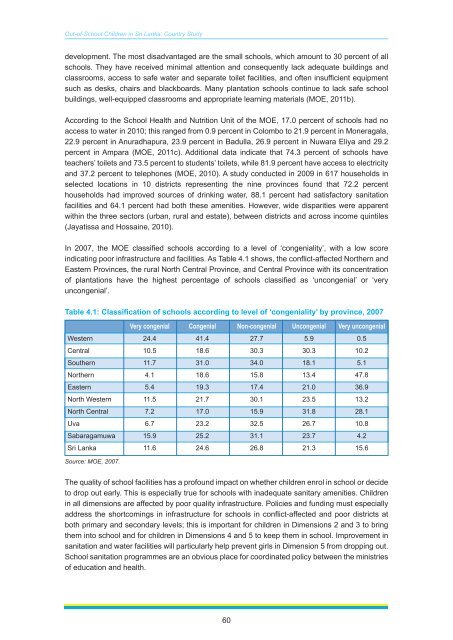Sri Lanka - Institut de statistique de l'Unesco
Sri Lanka - Institut de statistique de l'Unesco
Sri Lanka - Institut de statistique de l'Unesco
You also want an ePaper? Increase the reach of your titles
YUMPU automatically turns print PDFs into web optimized ePapers that Google loves.
Out-of-School Children in <strong>Sri</strong> <strong>Lanka</strong>: Country Study<br />
<strong>de</strong>velopment. The most disadvantaged are the small schools, which amount to 30 percent of all<br />
schools. They have received minimal attention and consequently lack a<strong>de</strong>quate buildings and<br />
classrooms, access to safe water and separate toilet facilities, and often insufficient equipment<br />
such as <strong>de</strong>sks, chairs and blackboards. Many plantation schools continue to lack safe school<br />
buildings, well-equipped classrooms and appropriate learning materials (MOE, 2011b).<br />
According to the School Health and Nutrition Unit of the MOE, 17.0 percent of schools had no<br />
access to water in 2010; this ranged from 0.9 percent in Colombo to 21.9 percent in Moneragala,<br />
22.9 percent in Anuradhapura, 23.9 percent in Badulla, 26.9 percent in Nuwara Eliya and 29.2<br />
percent in Ampara (MOE, 2011c). Additional data indicate that 74.3 percent of schools have<br />
teachers’ toilets and 73.5 percent to stu<strong>de</strong>nts’ toilets, while 81.9 percent have access to electricity<br />
and 37.2 percent to telephones (MOE, 2010). A study conducted in 2009 in 617 households in<br />
selected locations in 10 districts representing the nine provinces found that 72.2 percent<br />
households had improved sources of drinking water, 88.1 percent had satisfactory sanitation<br />
facilities and 64.1 percent had both these amenities. However, wi<strong>de</strong> disparities were apparent<br />
within the three sectors (urban, rural and estate), between districts and across income quintiles<br />
(Jayatissa and Hossaine, 2010).<br />
In 2007, the MOE classified schools according to a level of ‘congeniality’, with a low score<br />
indicating poor infrastructure and facilities. As Table 4.1 shows, the conflict-affected Northern and<br />
Eastern Provinces, the rural North Central Province, and Central Province with its concentration<br />
of plantations have the highest percentage of schools classified as ‘uncongenial’ or ‘very<br />
uncongenial’.<br />
Table 4.1: Classification of schools according to level of ‘congeniality’ by province, 2007<br />
Very congenial Congenial Non-congenial Uncongenial Very uncongenial<br />
Western 24.4 41.4 27.7 5.9 0.5<br />
Central 10.5 18.6 30.3 30.3 10.2<br />
Southern 11.7 31.0 34.0 18.1 5.1<br />
Northern 4.1 18.6 15.8 13.4 47.8<br />
Eastern 5.4 19.3 17.4 21.0 36.9<br />
North Western 11.5 21.7 30.1 23.5 13.2<br />
North Central 7.2 17.0 15.9 31.8 28.1<br />
Uva 6.7 23.2 32.5 26.7 10.8<br />
Sabaragamuwa 15.9 25.2 31.1 23.7 4.2<br />
<strong>Sri</strong> <strong>Lanka</strong> 11.6 24.6 26.8 21.3 15.6<br />
Source: MOE, 2007.<br />
The quality of school facilities has a profound impact on whether children enrol in school or <strong>de</strong>ci<strong>de</strong><br />
to drop out early. This is especially true for schools with ina<strong>de</strong>quate sanitary amenities. Children<br />
in all dimensions are affected by poor quality infrastructure. Policies and funding must especially<br />
address the shortcomings in infrastructure for schools in conflict-affected and poor districts at<br />
both primary and secondary levels; this is important for children in Dimensions 2 and 3 to bring<br />
them into school and for children in Dimensions 4 and 5 to keep them in school. Improvement in<br />
sanitation and water facilities will particularly help prevent girls in Dimension 5 from dropping out.<br />
School sanitation programmes are an obvious place for coordinated policy between the ministries<br />
of education and health.<br />
60

















